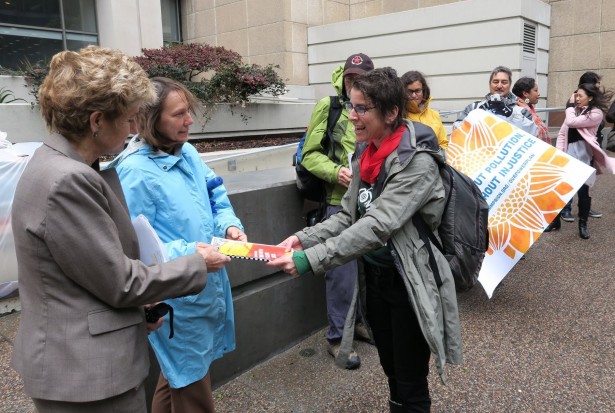Page added on January 22, 2016
Activists Deliver Plan for Just Transition to EPA Offices


Activists deliver the Our Power Plan to the EPA’s regional office in San Francisco on January 19. (Facebook/CEJA)
Yesterday, activists at each of the Environmental Protection Agency’s 10 regional offices issued their own corrective on the Obama administration’s Clean Power Plan. Days before the end of the federal comment period, the Climate Justice Alliance’s Our Power Campaign — comprised of 41 climate and environmental justice organizations — presented its Our Power Plan, which identifies “clear and specific strategies for implementing the Clean Power Plan, or CPP, in a way that will truly benefit our families’ health and our country’s economy.”
Introduced last summer, the CPP looks to bring down power plants’ carbon emissions by 32 percent from 2005 levels within 15 years. The plan was made possible by Massachusetts vs. EPA, a 2007 Supreme Court ruling which mandates that the agency regulate greenhouse gases as it has other toxins and pollutants under the Clean Air Act of 1963. Under the CPP, states are each required to draft their own implementation plans by September of this year, or by 2018 if granted an extension. If they fail to do so, state governments will be placed by default into an interstate carbon trading, or “Cap and Trade,” system to bring down emissions.
Michael Leon Guerrero, the Climate Justice Alliance’s interim coordinator, was in Paris for the most recent round of UN climate talks as part of the It Takes Roots Delegation, which brought together over 100 organizers from North American communities on the frontlines of both climate change and fossil fuel extraction. He sees the Our Power Plan as a logical next step for the group coming out of COP21, especially as the onus for implementing and improving the Paris agreement now falls to individual nations.
“Fundamentally,” he said, “we need to transform our economy and rebuild our communities. We can’t address the climate crisis in a cave without addressing issues of equity.”
The Our Power Plan, or OPP, is intended as a blueprint for governments and EPA administrators to address the needs of frontline communities as they draft their state-level plans over the next several months. (People living within three miles of a coal plant have incomes averaging 15 percent lower than average, and are eight percent more likely to be communities of color.) Included in the OPP are calls to bolster what CJA sees as the CPP’s more promising aspects, like renewable energy provisions, while eliminating proposed programs they see as more harmful. The CPP’s carbon trading scheme, CJA argues, allows polluters to buy “permissions to pollute,” or carbon credits, rather than actually stemming emissions.
The OPP further outlines ways that the EPA can ensure a “just transition” away from fossil fuels, encouraging states to invest in job creation, conduct equity analyses and “work with frontlines communities to develop definitions, indicators, and tracking and response systems that really account for impacts like health, energy use, cost of energy, climate vulnerability [and] cumulative risk.”
Lacking support from Congress, the Obama administration has relied on executive action to push through everything from environmental action to comprehensive immigration reform. The Clean Power Plan was central to the package Obama brought to Paris. Also central to COP21 was U.S. negotiators’ insistence on keeping its results non-binding, citing Republican lawmakers’ unwillingness to pass legislation.
Predictably, the CPP has faced legal challenges from the same forces, who decry the president for having overstepped the bounds of his authority. Republican state governments, utility companies, and fossil fuel industry groups have all filed suit against the CPP, with many asking for expedited hearings. Leading up the anti-CPP charge in Congress has been Senate Majority Leader Mitch McConnell, who has called the plan a “regulatory assault,” pitting fossil fuel industry workers against the EPA. “Here’s what is lost in this administration’s crusade for ideological purity,” he wrote in a November statement, “the livelihoods of our coal miners and their families.”
Organizers of Tuesday’s actions, however, were quick to point out that the Our Power Plan is aimed at strengthening — not defeating — the CPP as it stands. Denise Abdul-Rahman, of NAACP Indiana, helped organize an OPP delivery at the EPA’s Region 5 headquarters in Chicago, bringing out representatives from Black Lives Matter Minneapolis, National People’s Action and National Nurses United.
“We appreciate the integrity of the Clean Power Plan,” she said. “However, we believe it needs to be improved — from eliminating carbon trading to ensuring that there’s equity. We want to improve CPP by adding our voices and our plan, and we encourage the EPA to make it better.” Four of the six states in that region — which includes Illinois, Indiana, Michigan, Minnesota, Ohio and Wisconsin — are suing the EPA.
Endorsed by the National Domestic Workers’ Alliance, Greenpeace and the Center for Popular Democracy, among other organizations, yesterday’s national day of action on the EPA came as new details emerged in Flint, Michigan’s ongoing water crisis — along with calls for Michigan Gov. Rick Snyder’s resignation and arrest. The EPA has also admitted fault for its slow response to Flint residents’ complaints, writing in a statement this week that “necessary [EPA] actions were not taken as quickly as they should have been.”
Abdul-Rahman connected the water crisis with the need for a justly-implemented CPP. “The Flint government let their community down by not protecting our most precious asset, which is water,” she said. “The same is true of air: we need the highest standard of protecting human beings’ air, water, land.”
5 Comments on "Activists Deliver Plan for Just Transition to EPA Offices"


makati1 on Fri, 22nd Jan 2016 9:31 am
Dreamers…
Kenz300 on Fri, 22nd Jan 2016 10:09 am
Fossil fuels are the past………wind and solar are the future…
100% electric transportation and 100% solar by 2030 – AltCars Expo
https://www.youtube.com/watch?v=RBkND76J91k
———
How Is Climate Change Affecting the Philippines?
http://ecowatch.com/2016/01/22/climate-change-affecting-the-philippines/?utm_source=EcoWatch+List&utm_campaign=da3a287be1-Top_News_1_22_2016&utm_medium=email&utm_term=0_49c7d43dc9-da3a287be1-86023917
twocats on Fri, 22nd Jan 2016 11:53 am
Kenz – the speaker is a bit dry but its still a decent speech, though his analogies have some weaknesses.
https://www.youtube.com/watch?v=RBkND76J91k
Also the article you posted on Chinese EV sales (332k in 2015) was also a little misleading if you consider that total car sales are going up 2 million a year, and in 2013 alone was 18 million. I’m assuming its higher but that already only 1.8% of all sales being electric. Hardly a WOW number.
I know the doomers on site claim that EVs could never make a significant impact, but I do have one honest sincere question. Isn’t the fleet turnover rate right now in the US something like 12 years? So isn’t it conceivable that we could get a fairly quick turnover?
I’m guess some of the obstacles are: 1) about 50% of people can’t charge their EVs because they don’t own a home, and building that kind of curbside charging in every neighborhood would be nearly impossible; 2) manufacturing in US is fitted for ICEs not EV’s and it would take a number of years just to ramp up that production. 3) Is litium ion extraction scalable to that level.
makati1 on Fri, 22nd Jan 2016 5:49 pm
twocats, I think you answered your own question and shot down the possibility of electrics ever being a significant percentage of cars with the three questions at the end of your comment.
1. Soon, few will own a home of their own, just rent, so no outlets, and no five minute ‘fill-ups’ at the local gas station.
2. The failing Us economy would not let them switch even if they wanted to, which they do not. They only exist on taxpayer bailouts and don’t have the billions to make the changeover.
3. No, it is not. There is more than lithium in those batteries and electric cars. Not to mention that the turnover rate is, and will be, increasing in years, not shrinking. Another side effect of a shrinking economy and a depression.
A lot of the now obsolete suburban lifestyle built over the last 100 years is going to be trashed in the near future as it becomes impossible to maintain. Personal vehicles to public transport to shoe leather. Much of it will be abandoned to Mother Nature to recycle back into the soil.
makati1 on Fri, 22nd Jan 2016 6:05 pm
Kenz, interesting article, but nothing new. Similar facts could also relate to the US and the future hurricanes, tornadoes and blizzards. Difference is, the people here are used to it and accept it as part of reality. I could add in earthquakes and volcanoes, but the Us has those also in ever increasing numbers and strength.
There is no place in the world that is safe from Climate change, but I don’t have to worry about freezing to death in a blizzard or icy roads or…
“Atlantic, Caribbean storms more destructive as temperatures rise: study”
http://planetark.org/wen/74059
Or:
http://www.wdrb.com/story/30881799/nationwide-food-shortage-hitting-local-shoppers-in-the-wallet
I sleep well at night, do you?